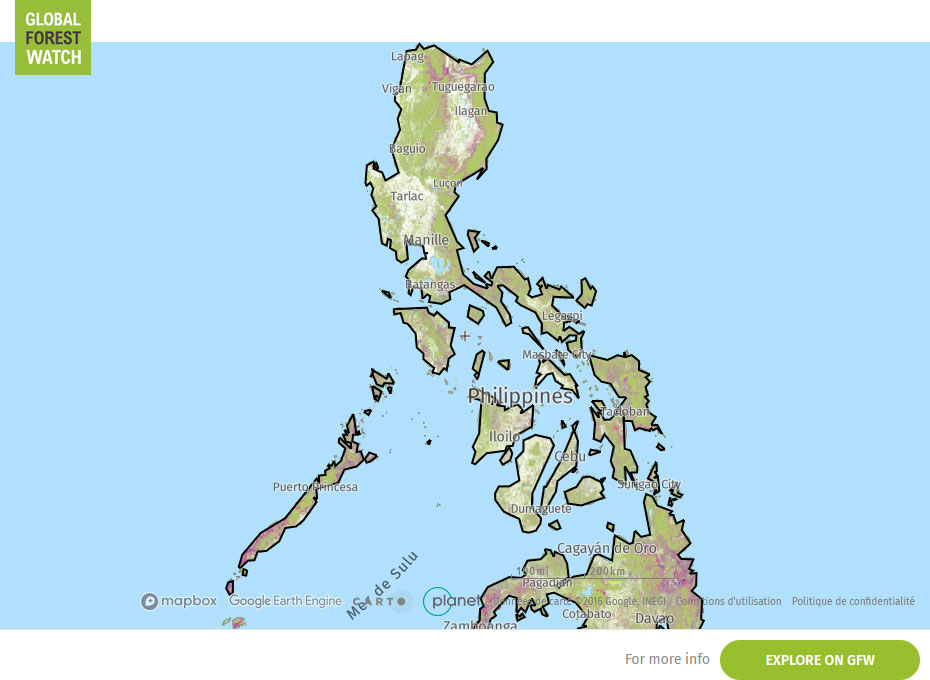Forest resources and context of Philippines
The Philippines, as of 2015, has a total forest land area of 15, 805,325 hectares with a forest cover of 7,014,152 hectares (44%) (FMB, 2019).

Land surface
29.8million ha
Forest cover
7.2million ha
Production forest
1.9million ha
Forest ownership
63.8% publicly
Forest resources in Philippines
Types of forest
Forest cover is classified into three types:
- Closed forest - Formation where trees in various storey and undergrowth cover a high proportion (>40 percent) of the ground and do not have a continuous dense grass layer. Currently, it constitutes 28.9 % (2,028, 015 hectares) of the Philippines forest cover (2015 data). (FMB PFAG 2020).
- Open forest - Formations with discontinuous tree layer with coverage of at least 10% and less than 40%. At present, it constitutes 66.8 % (4, 682, 764 hectares) of the total Philippine forest cover (2015 data). (FMB PFAG 2020).
- Mangrove forest - Forested wetland growing along tidal mudflats and along shallow water coastal areas extending inland along rivers, streams and their tributaries where the water is generally brackish. It constitutes 4.3 % (303, 373 hectares) of the current Philippine forest cover (2015 data). (FMB PFAG 2020).
The Philippines, as of 2015, has a total forest land area of 15, 805,325 hectares with a forest cover of 7,014,152 hectares (44%) (FMB, 2019). Steady deforestation rates were observed from 1970 to 2010, with Philippines having about 7 M hectares of forest cover remaining. Forest loss is mainly driven by forest extraction (logging – legal and illegal), agricultural expansion (upland cultivation in forest areas), and infrastructure development (demand for timber products, roadside clearing, and river bound colonization) - Carandang et al. 2013.
About 26% of the Philippine forests are found in the 240 protected areas (covering 5.45 M ha) listed under the National Integrated Protected System (NIPAS) as of 2013 (BMB, 2015). This law was further enhanced thru RA No. 11038 Expanded NIPAS of 2018.
Field offices of DENR (Department of Environment and Natural Resources) exist in 13 departmental regional offices, 81 provincial offices (DENR PENRO – Provincial Environment and Natural Resources Office) and 141 community offices (DENR-CENRO (Community Environment and Natural Resources Office).
Forest ownership in Philippines
All forest lands are regarded as a public domain thus, such lands belong to the State under the 1987 Philippine Constitution, Art. XII, Sec. 2 and Sec. 3. Existing legal tenure instruments governing forest landownership are:
- Community-Based Forest Management Agreement (CBFMA) under the EO 263. CBFMA is an agreement entered into by and between the government and a local community, represented by the People’s Organization as forest managers, wherein the latter is granted the right to develop, utilize, manage and conserve specific portions of forest lands for a period of 25 years renewable for another 25 years.
- Certificate of Stewardship Contract (CSC) under the Integrated Social Forestry Program (ISFP) Letter of Instruction 1260 of 1982 and EO 263, it is a contract awarded to individuals or families actually occupying or tilling portions of forest lands for a period of 25 years renewable for another 25 years within the CBFMA area. (DAO 2004-29).
- Integrated Forest Management Agreement (IFMA) as per DAO 99-53 is a production sharing contract entered into by and between the government, through the Department of Environment and Natural Resources (DENR) and a qualified applicant wherein the latter is granted the right to develop, manage, protect and utilize a specified area of forestland and forest resources therein for a period of 25 years renewable for another 25 years.
- Socialized Industrial Forest Management Agreement (SIFMA) as per DAO 30-2004 is an agreement entered into by and between a natural or juridical person and the government thru DENR wherein the latter grants to the former the right to develop, utilize and manage a small tract of forestland consistent with the principle of sustainable development with a duration of 25 years renewable for another 25 years.
- Certificate of Ancestral Domain Title (CADT). Under RA 8371 – The Indigenous Peoples’ Rights Act of 1997 is a certificate of domain title formally recognizing the rights of possession and ownership of indigenous cultural community/indigenous people (ICC/IP) over their ancestral domains identified and delineated in accordance with the law.
- Certificate of Ancestral Land Title (CALT) Under RA 8371 – The Indigenous Peoples’ Rights Act of 1997 is a certificate of land title being issued by the National Commission of Indigenous People (NCIP) formally recognizing the rights of ICCs/ IPs over their ancestral lands.
key figures
| Land surface | 29.8 million hectares |
|---|---|
| Forest cover | 7.2 million hectares (24.2%); mostly naturally regenerated forest (82%) and primary forest (12%) 0.3 million hectares of planted forest |
| Production forest | 1.9 million hectares designated for production |
| Forest ownership | 63.8% publicly owned 36.2% privately owned |
| Annual change rate | 0.5 % per year; over the past 10 years (2010-2020) |
Source: FAO, 2020
See also: Global Forest Ressources Assessment 2020, FAO



